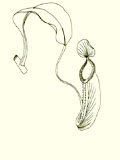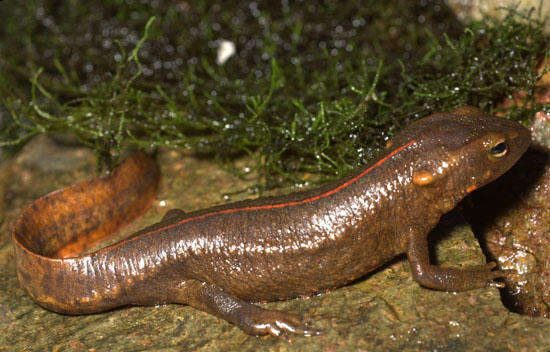

 |
 |
Diversity At A Glance (pdf)
This column aims to introduce interesting species of Hong Kong flora and fauna that might be encountered during fieldwork. Distinctive physical characteristics and some interesting ecological facts are included for each example. If you wish to contribute to this column, or have any comments or suggestions, please contact eitherJacqueline Weir (jesweir@hkusua.hku.hk) or Sukh Mantel (skmantel@hkusua.hku.hk)
|
|
|
|
|
'Hong Kong Newt (Paramesotriton hongkongensis)'
by Dr Leung Sze Lun, Alan
Of the 23 species of amphibians in Hong Kong, there is only a single species of salamander, also known as "tailed amphibians", naturally occurring in Hong Kong and this is the Hong Kong newt, Paramesotriton hongkongensis. The species is endemic to Guangdong, including Hong Kong, and protected by law under the Wild Animals Protection Ordinance Cp. 170 Schedule 2. The adult length, from snout to the end of the tail, is about 11 to 14 cm, with four legs similar in size. The body colour ranges from light brown to dark brown with some patches of orange markings scattered on the ventral side of the body. The patterns of the patches are unique for each individual, just like the fingerprints of humans. The tadpoles have some finger-like gills around their necks which are usually absent in frog and toad tadpoles, and the gills disappear after metamorphosis to adult.
The Hong Kong newts undergo seasonal breeding migrations. Each year after the end of the wet season around October, the newts move into the stream pools. After breeding, they will eventually leave the pools around December, but the information on where they go is still poor. From a Hong Kong newt migration study I carried out during 1996 to 1997 "The seasonal migration and diet of Hong Kong Newts, Paramesotriton hongkongensis in KFBG and Tai Tam", it was found that at the beginning of the breeding season, the newt population in pools was male-biased. Towards the end of the breeding season, the newt population tended to become female-biased. The males that breed quicker than others may have an advantage since their offspring can hatch earlier. As cannibalism is common in this species, being "bigger" can reduce the risk of being eaten.
 |
Fig. 2. ‘Hong Kong Newt’ Paramesotriton hongkongensis
|
|
P.16 |
|
Porcupine! |
 Copyright © 2000 |